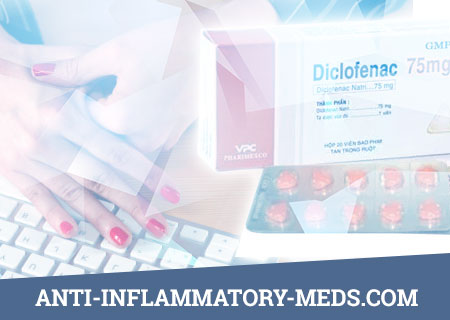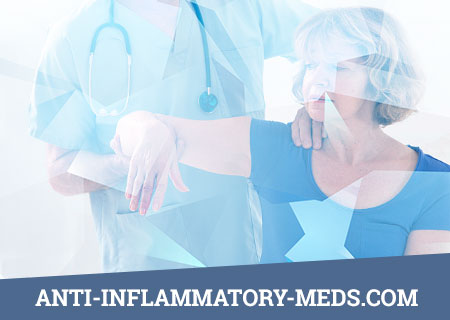Pharmachologic effect
Nonsteroidal anti-inflammatory drug (NSAIDs), a derivative of phenylacetic acid. Diclofenac has anti-inflammatory, analgesic, antiplatelet and antipyretic effects. Indirectly inhibiting cyclooxygenase 1 and 2 (COX1 and COX2), violates the metabolism of arachidonic acid, reduces the number of prostaglandins in the focus of inflammation. Most effective for inflammatory pain.
In rheumatic diseases, the anti-inflammatory and analgesic effect of diclofenac significantly reduces the severity of pain, morning stiffness, swelling of the joints, which improves the functional state of the joint.

With injuries in the postoperative period, diclofenac reduces pain and inflammatory edema.
Pharmacokinetics
Absorption is fast and complete, food slows down the absorption rate by 1–4 hours and reduces the maximum concentration (Cmax) by 40%. After oral administration of 50 mg, the maximum concentration (Cmax) —1.5 μg/ml is reached in 2–3 h. The concentration in plasma is in a linear relationship with the dose administered.
After oral administration of tablets, 100 mg Cmax - 0.5 μg/ml is achieved in 4–5 hours.
Changes in the pharmacokinetics of diclofenac against the background of repeated administration is not observed. It does not accumulate while observing the recommended interval between meals.
Bioavailability - 50%. Communication with plasma proteins - more than 99% (most associated with albumin). Gets into synovial fluid; Cmax in synovial fluid is observed 2–4 hours later than in plasma. The half-life (T1/2) of synovial fluid is 3–6 h (the concentration of the active substance in synovial fluid 4–6 h after drug administration is higher than in plasma, and remains higher for 12 more hours).
The relationship of drug concentration in synovial fluid with the clinical efficacy of the drug has not been elucidated.
Metabolism: 50% of the active substance is metabolized during the "first pass" through the liver. Metabolism occurs as a result of repeated or single hydroxylation and conjugation with glucuronic acid. The enzyme system of P450 CYP2C9 is involved in the metabolism of the drug.
Pharmacological activity of metabolites is lower than diclofenac.
Systemic clearance is about 260 ± 50 ml/min, the volume of distribution - 550 ml/kg. T1/2 of plasma averages about 2.5 hours. 65% of the administered dose is excreted in the form of metabolites by the kidneys; less than 1% is excreted unchanged, the rest of the dose is excreted in the form of metabolites with bile.
In patients with severe renal insufficiency (clearance of creatinine QC less than 10 ml/min) increases the excretion of metabolites from the bile, while increasing their concentration in the blood is not observed.
In patients with chronic hepatitis or compensated liver cirrhosis, the pharmacokinetic parameters of diclofenac do not change.
Diclofenac penetrates into breast milk.
Indications for use
Symptomatic treatment of diseases of the musculoskeletal system (rheumatoid arthritis, psoriatic arthritis, juvenile chronic arthritis, ankylosing spondylitis (ankylosing spondylitis), gouty arthritis, rheumatic soft tissue, osteoarthritis peripheral joints and spine, including radicular syndrome, tenosynovitis, bursitis).
The drug relieves or reduces pain and inflammation during treatment, while not affecting the progression of the disease.
Pain syndrome of mild or moderate severity: neuralgia, myalgia, lumboischialgia, post-traumatic pain syndrome accompanied by inflammation, postoperative pain, headache, migraine, algomenorrhea, adnexitis, proctitis, toothache.
In the complex treatment of infectious and inflammatory diseases of the ear, throat, nose with severe pain (pharyngitis, tonsillitis, otitis media).
Contraindications
- Hypersensitivity to the active substance (including other NSAIDs) or auxiliary components;
- Anamnestic data on the attack of bronchial obstruction, rhinitis, urticaria after taking acetylsalicylic acid or other NSAIDs (complete or incomplete intolerance syndrome of acetylsalicylic acid - rhinosinusitis, urticaria, nasal polyps, asthma);
- Erosive and ulcerative changes of the gastric mucosa or duodenum 12, active gastrointestinal bleeding;
- Inflammatory bowel disease (ulcerative colitis, Crohn's disease) in the acute phase;
- The period after coronary artery bypass surgery;
- III trimester of pregnancy, breastfeeding period;
- Decompensated heart failure;
- Hematopoietic disorders, hemostasis disorders (including hemophilia);
- Severe liver failure or active liver disease;
- Severe renal failure (creatinine clearance less than 30 ml/min); progressive kidney disease, incl. confirmed hyperkalemia;
- Children's age up to 15 years - for tablets of 50 mg and up to 18 years of age - for tablets of 100 mg;
- Patients with rare hereditary diseases, such as galactose intolerance, lactase deficiency or glucose-galactose malabsorption, take the drug (50 mg tablets) is contraindicated.
Carefully
Anemia, bronchial asthma, cerebrovascular diseases, coronary heart disease, congestive heart failure, arterial hypertension, peripheral artery disease, edematous syndrome, hepatic or renal failure (creatinine clearance less than 60 ml/min), dyslipidemia / hyperlipidemia, diabetes, smoking, inflammation intestinal diseases, condition after extensive surgical interventions, induced porphyria. diverticulitis, systemic connective tissue diseases, pregnancy I – II trimester.
Anamnestic data on the development of ulcerative diseases of the gastrointestinal tract, the presence of Helicobacter pylori infection, old age, long-term use of NSAIDs, frequent use of alcohol, severe somatic diseases.

Simultaneous therapy with anticoagulants (for example, warfarin), antiplatelet agents (for example, acetylsalicylic acid, clopidogrel), oral glucocorticosteroids (for example, prednisolone), selective serotonin reuptake inhibitors (for example, citalopram, fluoxetine, paroxetine, serrallin)
Side effect
Often - 1–10%; sometimes, 0.1–1%; rarely, 0.01–0.1%; very rarely, less than 0.001%, including some cases.
On the part of the digestive system: often - epigastric pain, nausea, vomiting, diarrhea, dyspepsia, flatulence, anorexia, increased activity of aminotransferases; rarely - gastritis, proctitis, bleeding from the gastrointestinal tract (GIT) (vomiting with blood, melena, diarrhea with blood), gastrointestinal ulcers (with or without bleeding or perforation), hepatitis, jaundice, impaired liver function; very rarely - stomatitis, glossitis, esophagitis, nonspecific hemorrhagic colitis, exacerbation of ulcerative colitis or Crohn's disease, constipation, pancreatitis, fulminant hepatitis.
On the part of the nervous system: often - headache, dizziness; rarely - drowsiness; very rarely - a violation of sensitivity, incl. paresthesias, memory disorders, tremor, convulsions, anxiety, cerebrovascular disorders, aseptic meningitis, disorientation, depression, insomnia, nightmares, irritability, mental disorders.
From the senses: often - vertigo; very seldom - visual impairment (blurred vision, diplopia), hearing loss, tinnitus, taste impairment.
On the part of the urinary system: very rarely - acute renal failure, hematuria, proteinuria, interstitial nephritis, nephrotic syndrome, papillary necrosis.
From the side of blood-forming organs: very rarely - thrombocytopenia, leukopenia, hemolytic and aplastic anemia, agranulocytosis.
Allergic reactions: anaphylactic / anaphylactoid reactions, including marked reduction in blood pressure (BP) and shock; very rarely - angioedema (including faces).
Since the cardiovascular system: very rarely - heartbeat, chest pain, high blood pressure, vasculitis, heart failure, myocardial infarction.
On the part of the respiratory system: rarely - exacerbation of bronchial asthma; very rarely - pneumonitis.
On the part of the skin: often - skin rash; rarely - urticaria; very rarely - bullous eruptions, eczema, incl. multiforme and Stevens-Johnson syndrome, Lyell's syndrome, exfoliative dermatitis, pruritus, hair loss, photosensitization, purpura, incl. allergic.
Overdose
Symptoms: vomiting, bleeding from the gastrointestinal tract, diarrhea, dizziness, tinnitus, convulsions, increased blood pressure, respiratory depression, with a significant overdose - acute renal failure, hepatotoxic effect.
Treatment: gastric lavage, activated carbon, symptomatic therapy aimed at eliminating increased blood pressure, impaired renal function, seizures, gastrointestinal irritation, respiratory depression. Forced diuresis, hemodialysis are ineffective (due to a significant connection with proteins and intensive metabolism).
Interaction with other drugs
Increases plasma concentration of digoxin, methotrexate, lithium and cyclosporine drugs.
Reduces the effect of diuretics, increases the risk of hyperkalemia; against the background of anticoagulants, thrombolytic agents (alteplaza, streptokinase, urokinase) - the risk of bleeding (usually from the gastrointestinal tract).
Reduce the effects of hypotensive and hypnotic drugs.
NSAIDs and glucocorticosteroids increase the toxicity of the methotrexate and cyclosporine nephrotoxicity.
Concentration of diclofenac in the blood.
At the same time, it is taking advantage of the paraphilic effect on the nephrotoxic effects of diclofenac.
Reduce the effect of hypoglycemic agents.
Cefamundol, cefoperazone, cefotetan, valproic acid and plykamycin increase the incidence of hypoprothrombinemia.
The effect of diclofenac in the kidneys, which increases nephrotoxicity.
The ethanol, colchicine, corticotropin, serotonin reuptake inhibitors and drugs. John's wort increases the risk of bleeding in the gastrointestinal tract.
Enhances the effect of drugs that cause photosensitization.
Drugs that increase the concentration of diclofenac, increasing its toxicity.
Anti-bacterial drugs from the quinolone group - the risk of seizures.
Impact on laboratory test results can be corrected, and should also be noted.
Special instructions
30 minutes before a meal. In other cases, take before, during or after a meal, without drinking, drinking plenty of water.
If you are taking care of a patient, you can take care of your child’s life. circulating blood volume (, after extensive surgical intervention).
If diclofenac is prescribed in such cases, it is recommended.
In case of patients with less than 10 ml/min, plasma css metabolites should not be observed.
In patients with hepatic impairment (chronic hepatitis, compensated for liver cirrhosis). Peripheral blood picture, stool analysis for occult blood.
It is recommended that women want to become pregnant. In patients with infertility (including those undergoing examination), it is recommended.
Care must be taken when sharing with ACE inhibitors, beta-blockers; digoxin; in the treatment of nephrotoxic drugs, zidovudine.
It is a fact that it has been shown that it has been the case for the psychomotor reactions.
It is possible to reduce the risk of possible adverse events from the gastrointestinal tract.
When taking tablets 100 mg patients with diabetes mellitus should be taken (1 tablet - 94.7880 mg of sucrose).
Patients taking refiners should refrain from drinking alcohol.
 US
US UK
UK CA
CA DE
DE FR
FR IT
IT ES
ES



